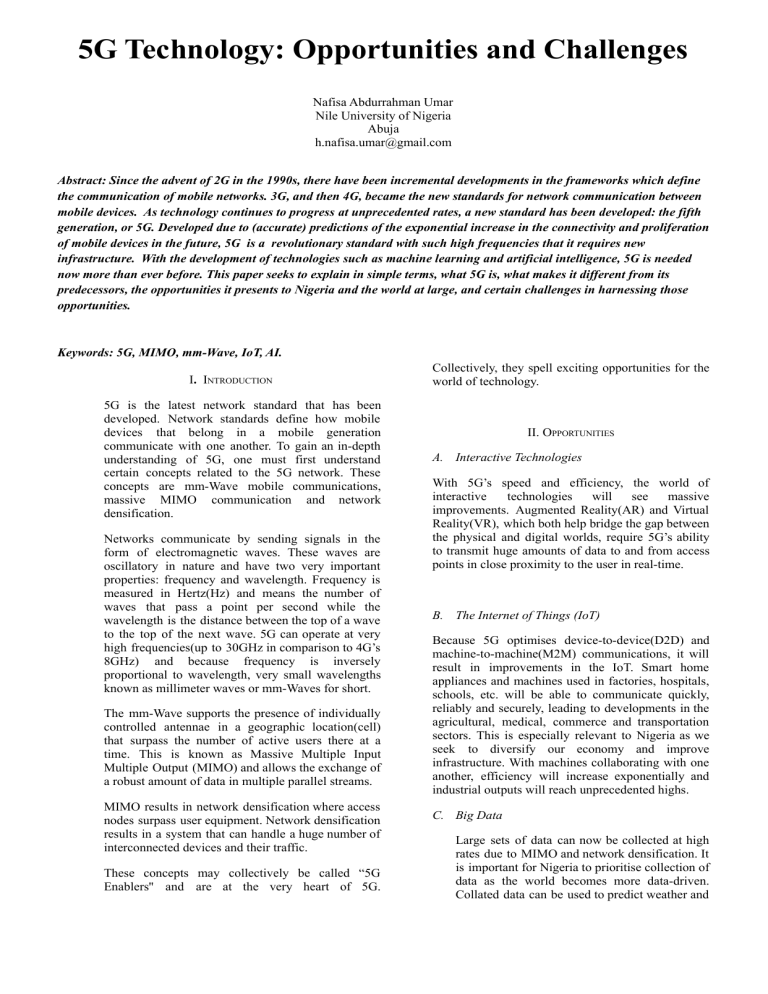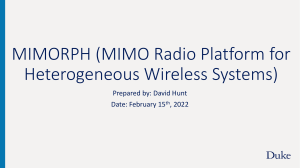
5G Technology: Opportunities and Challenges Nafisa Abdurrahman Umar Nile University of Nigeria Abuja h.nafisa.umar@gmail.com Abstract: Since the advent of 2G in the 1990s, there have been incremental developments in the frameworks which define the communication of mobile networks. 3G, and then 4G, became the new standards for network communication between mobile devices. As technology continues to progress at unprecedented rates, a new standard has been developed: the fifth generation, or 5G. Developed due to (accurate) predictions of the exponential increase in the connectivity and proliferation of mobile devices in the future, 5G is a revolutionary standard with such high frequencies that it requires new infrastructure. With the development of technologies such as machine learning and artificial intelligence, 5G is needed now more than ever before. This paper seeks to explain in simple terms, what 5G is, what makes it different from its predecessors, the opportunities it presents to Nigeria and the world at large, and certain challenges in harnessing those opportunities. Keywords: 5G, MIMO, mm-Wave, IoT, AI. I. INTRODUCTION Collectively, they spell exciting opportunities for the world of technology. 5G is the latest network standard that has been developed. Network standards define how mobile devices that belong in a mobile generation communicate with one another. To gain an in-depth understanding of 5G, one must first understand certain concepts related to the 5G network. These concepts are mm-Wave mobile communications, massive MIMO communication and network densification. A. Interactive Technologies Networks communicate by sending signals in the form of electromagnetic waves. These waves are oscillatory in nature and have two very important properties: frequency and wavelength. Frequency is measured in Hertz(Hz) and means the number of waves that pass a point per second while the wavelength is the distance between the top of a wave to the top of the next wave. 5G can operate at very high frequencies(up to 30GHz in comparison to 4G’s 8GHz) and because frequency is inversely proportional to wavelength, very small wavelengths known as millimeter waves or mm-Waves for short. B. The Internet of Things (IoT) The mm-Wave supports the presence of individually controlled antennae in a geographic location(cell) that surpass the number of active users there at a time. This is known as Massive Multiple Input Multiple Output (MIMO) and allows the exchange of a robust amount of data in multiple parallel streams. MIMO results in network densification where access nodes surpass user equipment. Network densification results in a system that can handle a huge number of interconnected devices and their traffic. These concepts may collectively be called “5G Enablers'' and are at the very heart of 5G. II. OPPORTUNITIES With 5G’s speed and efficiency, the world of interactive technologies will see massive improvements. Augmented Reality(AR) and Virtual Reality(VR), which both help bridge the gap between the physical and digital worlds, require 5G’s ability to transmit huge amounts of data to and from access points in close proximity to the user in real-time. Because 5G optimises device-to-device(D2D) and machine-to-machine(M2M) communications, it will result in improvements in the IoT. Smart home appliances and machines used in factories, hospitals, schools, etc. will be able to communicate quickly, reliably and securely, leading to developments in the agricultural, medical, commerce and transportation sectors. This is especially relevant to Nigeria as we seek to diversify our economy and improve infrastructure. With machines collaborating with one another, efficiency will increase exponentially and industrial outputs will reach unprecedented highs. C. Big Data Large sets of data can now be collected at high rates due to MIMO and network densification. It is important for Nigeria to prioritise collection of data as the world becomes more data-driven. Collated data can be used to predict weather and natural disasters, for government planning activities and to understand trends. This will enable us to understand our world better and make well-informed decisions. D. Artificial Intelligence and Machine Learning Artificial Intelligence is a field of science that is concerned with providing machines with the cognitive and decision making abilities found in humans. Machine learning(ML) is a type of AI that creates programs which analyse data and use it to make future decisions. Machine learning is used in big data analytics to make the process of analysing large amounts of data quicker and more efficient. B. Isotropic Path loss The higher the frequency of a wave, the more path loss it experiences. This just means that after travelling a certain distance in free space, the wave results in varying signals. Also, 5G waves cannot penetrate solid barriers like walls as well as 4G can. This can be solved by making multiple paths available to waves. C. High Levels Of Change To properly implement and utilise 5g, a lot of brand new infrastructure needs to be provided. Machines must be built or adapted to support MIMO, M2M communications, and many more technologies. IV. CONCLUSION E. High Performance Infrastructure 5G will enable efficient communication between vehicles and infrastructure. Driverless trains, buses and cars can reach high levels of precision due to the speed with which 5G can transmit information in real time. Additionally, 5G will enable experts to fix any bugs in automated parts of infrastructure remotely. M2M communication also improves the quality of infrastructure. For example, different trains would easily be able to communicate with each other. As promising as these opportunities sound, certain properties make the implementation of 5G a little challenging. III. CHALLENGES A. Shorter Range Of Mm-waves Networks that communicate in waves with shorter wavelengths cover much smaller geographical areas. Even though this property is useful for reusing frequencies of the same bandwidth for different things, it necessitates the creation of an increased number of smaller cells(geographic areas covered by networks). 5G opens up a world of possibilities for us. Effectively utilising this new technology and the benefits it brings will transform Nigeria economically and infrastructurally. Efficiency and precision in healthcare, agriculture and commerce will be like never before. Better yet, the possible challenges it could present are not at all insurmountable. V. REFERENCES [1] Angeliki Alexiou, 5G Wireless Technologies. United Kingdom: The Institution of Engineering and Technology, London, 2017. [2] Devaki Chandramuli, Rainer Liebhart and Juho Pirskanen, 5G for the Connected World. America: John Wiley & Sons, 2019. [3] Shahid Mumtaz, Jonathan Rodriquez and Linglong Dai, Wave Massive MIMO: A Paradigm for 5G. United Kingdom: Academic Press, 2017. [4] V. K Sachan, Fundamentals of 5G Wireless Communications. India: Smt. Jay Devi Sachan Memorial Publication House, 2020. [5] Wei Xiang, Kan Zheng and Xuemin Shen, 5G Mobile Communications. Switzerland: Springer, 2017




